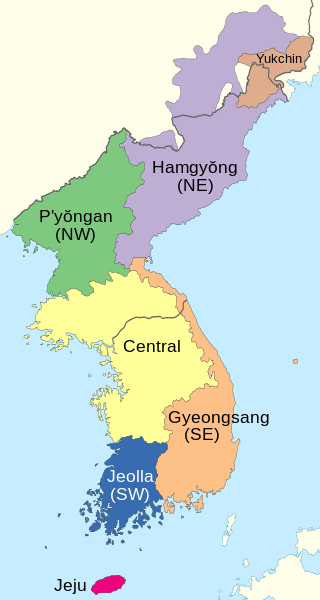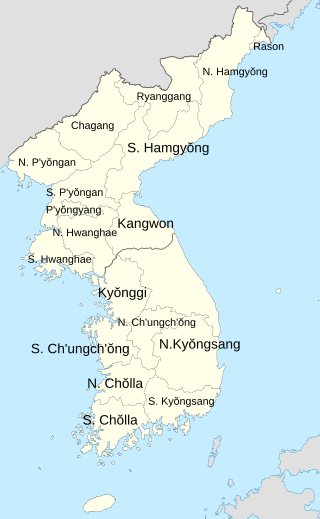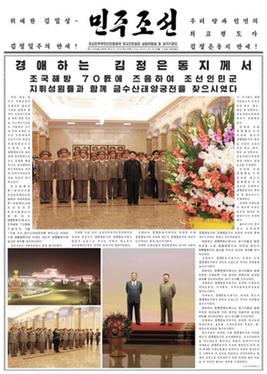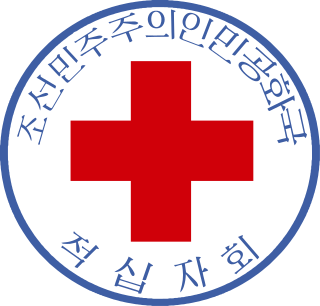Korea's provinces have been the primary administrative division of Korea since the mid Goryeo (Koryo) dynasty in the early 11th century, and were preceded by provincial-level divisions dating back to Unified Silla, in the late 7th century.

North Hwanghae Province is a province of North Korea. The province was formed in 1954 when the former Hwanghae Province was split into North and South Hwanghae. The provincial capital is Sariwon. The province is bordered by Pyongyang and South Pyongan to the north, Kangwon to the east, Kaesong Industrial Region and South Korea's Gyeonggi Province to the south, and South Hwanghae southwest. In 2003, Kaesong Directly Governed City became part of North Hwanghae as Kaepung County. Later on in 2019, it was promoted as Special City. Thus, it was separated from North Hwanghae.

Kangwon Province is a province of North Korea, with its capital at Wŏnsan. Before the division of Korea in 1945, Kangwŏn Province and its South Korean neighbour Gangwon Province formed a single province that excluded Wŏnsan.

South Pyongan Province is a province of North Korea. The province was formed in 1896 from the southern half of the former Pyongan Province, remained a province of Korea until 1945, then became a province of North Korea. Its capital is Pyongsong.

South Hamgyong Province is a province of North Korea. The province was formed in 1896 from the southern half of the former Hamgyong Province, remained a province of Korea until 1945, then became a province of North Korea. Its capital is Hamhung.
The Choson Sinbo, also known by the name of its English edition The People's Korea, is a newspaper based in Japan, published in both Korean and Japanese. The name literally means 'Chosun (Korea) Newspaper'. It is published by the General Association of Korean Residents, a pro-North Korea representative body for Zainichi Koreans, who also run The People's Korea (PK), an English language news site.

A number of Korean dialects are spoken on the Korean Peninsula. The peninsula is very mountainous and each dialect's "territory" corresponds closely to the natural boundaries between different geographical regions of Korea. Most of the dialects are named for one of the traditional Eight Provinces of Korea. Two are sufficiently distinct from the others to be considered separate languages, the Jeju and the Yukjin languages.

Typhoon Rusa was the most powerful typhoon to strike South Korea in 43 years. It was the 21st JTWC tropical depression, the 15th named storm, and the 10th typhoon of the 2002 Pacific typhoon season. It developed on August 22 from the monsoon trough in the northwestern Pacific Ocean, well to the southeast of Japan. For several days, Rusa moved to the northwest, eventually intensifying into a powerful typhoon. On August 26, the storm moved across the Amami Islands of Japan, where Rusa left 20,000 people without power and caused two fatalities. Across Japan, the typhoon dropped torrential rainfall peaking at 902 mm (35.5 in) in Tokushima Prefecture.
The North Korean Famine, also known as the Arduous March or the March of Suffering, was a period of mass starvation together with a general economic crisis from 1994 to 1998 in North Korea. During this time there was an increase in defection from North Korea which peaked towards the end of the famine period.

Provinces are the first-level division within North Korea. There are 9 provinces in North Korea: Chagang, North Hamgyong, South Hamgyong, North Hwanghae, South Hwanghae, Kangwon, North Pyongan, South Pyongan, and Ryanggang.

Severe Tropical Storm Meari, known in the Philippines as Tropical Storm Falcon, was an unusually large tropical cyclone that caused significant damage from the Philippines to the Korean Peninsula in June 2011.
Munch'ŏn station (Korean: 문천역) is a railway station in Munch'ŏn-dong, greater Munch'ŏn city, Kangwŏn province, North Korea, on the Kangwŏn Line of the Korean State Railway. Originally called Munp'yŏng station, the station, along with the rest of the Okp'yŏng–Wŏnsan section of the former Hamgyŏng Line, was opened by the Japanese on 1 August 1915. It received its current name after the establishment of the DPRK.

Minju Choson is a state-run North Korean government newspaper. It is published in Pyongyang. It was started in 1945. It is the principal newspaper of the Cabinet of North Korea and the Standing Committee of the Supreme People's Assembly.

Severe Tropical Storm Khanun, known in the Philippines as Tropical Storm Enteng, was the first tropical cyclone to directly impact Korea in two years. It is the 8th named storm, the 3rd severe tropical storm, and overall, the 13th tropical cyclone to be monitored by the Japan Meteorological Agency (JMA) during 2012. Khanun was also the first tropical storm to make a landfall over Korea in 2012. Khanun means "jack fruit" in Thai.

The 2012 North Korean floods began in mid-July 2012 when Tropical Storm Khanun affected parts of the country, killing at least 88 people and leaving more than 62,000 people homeless. Torrential rains on 29 and 30 July 2012 worsened the situation, causing additional damage and casualties and forcing the government to request international assistance. Severe rainfall also affected the southern region of North Korea in August, killing at least six.

The Red Cross Society of the Democratic People's Republic of Korea is the national Red Cross Society of North Korea. It was founded as the Red Cross Society of North Korea on 18 October 1946 by the Soviet-backed occupational government.

Typhoon Lionrock, known in the Philippines as Typhoon Dindo, was a large, powerful, long-lived and erratic tropical cyclone which caused significant flooding and casualties in North Korea and Japan in late August 2016. It was the tenth named storm and was the third typhoon of the 2016 Pacific typhoon season. Damages recorded after the season were recorded about US$3.93 billion.

The 2016 North Korean floods began in late-August 2016 as a consequence of Typhoon Lionrock, killing at least 525 people, destroying more than 35,000 homes, and leaving over 100,000 people homeless, mainly in the North Hamgyong Province. The floods occurred when the Tumen River, near the borders with China and Russia, broke its banks, according to the United Nations Office for the Coordination of Humanitarian Affairs and Red Cross.

The 2018 North Korean floods began on 28 August 2018, killing at least 76 people, leaving around 75 more missing, destroying more than 800 buildings, and causing about 10,700 people to become homeless.













